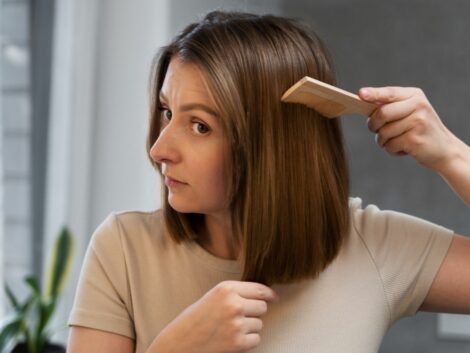Yes, hair growth can vary between genders in several patterns:
Hormonal Differences
Hormones play a significant role in hair growth; men and women have different hormonal profiles. Testosterone, for example, is a hormone that promotes hair growth in men, leading to thicker and coarser hair, particularly on the face and body. In contrast, women have lower levels of testosterone and higher levels of estrogen, which can result in finer and slower-growing hair.
Pattern of Hair Growth
Men tend to have more noticeable patterns of hair growth, such as facial hair and often more pronounced body hair, while women
typically have finer and less visible body hair.
Hair Loss
While both men and women can experience hair loss, the pattern and extent can differ between the genders. For example, men are more likely to experience male pattern baldness, typically resulting in a receding hairline and a thinning crown. Women, on the other hand, are more likely to experience diffuse hair thinning throughout the scalp.
Both men and women can experience changes in hair growth as they age. Men may experience thinning of the hair on the scalp and an increase in body hair, while women may experience a decrease in hair density and changes in hair texture.
Overall, while there are some general differences in hair growth between genders, individual variations in hormonal levels and genetics can also play a significant role.
Is There Scientific Evidence Supporting Differences in Hair Growth Rates Between Genders?
Yes, scientific evidence supports differences in hair growth rates between genders. Research has shown that hormonal differences between men and women can impact hair growth. For example, a study published in the journal Hormones and Behavior found that androgens, such as testosterone, significantly stimulate hair growth in men. These hormones can promote the growth of thicker and coarser hair, particularly on the face and body.
In contrast, women typically have lower levels of androgens and higher estrogen levels, which can result in finer and slower-growing hair. Studies have also shown that hormonal changes, such as those associated with menopause, can affect hair growth in women, leading to hair texture and density changes.
Furthermore, genetic differences can also play a role in hair growth rates between genders. For example, genes associated with baldness and hair thickness have been linked to differences in hair growth between men and women.
Scientific research supports the idea that hormonal and genetic factors contribute to differences in hair growth rates between genders.
What Factors Influence the Rate of Hair Growth in Males and Females?
Several factors can influence the rate of hair growth in both males and females. These factors include:
Hormones
Hormones such as androgens (e.g., testosterone) and estrogens play a significant role in hair growth. Androgens are responsible for promoting the development of thicker and coarser hair, particularly in men. In comparison, lower levels of androgens and higher levels of estrogens in women can result in finer and slower-growing hair.
Genetics
Genetic factors can also play a role in determining hair growth rates. Certain genetic traits can influence the thickness, texture, and overall hair growth rate in both men and women.
Age
Hair growth rates can change with age. As people get older, hair growth tends to slow down, and the quality of the hair may also vary.
Nutritional Factors
A balanced diet that includes essential nutrients such as protein, vitamins (particularly B vitamins), and minerals like iron can contribute to healthy hair growth in both men and women.
Health Conditions
Certain health conditions, such as thyroid disorders or autoimmune diseases, can impact hair growth. Medications, stress, and underlying health issues can also affect the rate of hair growth.
Hair Care Practices
Hair care routines and styling practices can impact the health and growth of hair. For example, excessive heat styling, chemical treatments, or tight hairstyles can damage the hair and potentially slow down growth.
Environmental Factors
Environmental factors such as exposure to pollutants, UV radiation, and climate can also influence hair growth and overall hair health.
Overall, a combination of genetic, hormonal, nutritional, and environmental factors can influence the rate of hair growth in both males and females. Understanding these factors can help individuals take steps to promote healthy hair growth.

How Do Hormones & Genetics Impact the Speed of Hair Growth Between Different Genders?
Hormones and genetics can play a significant role in influencing the speed of hair growth between different genders.
Hormones
- Androgens, such as testosterone, are male hormones that are responsible for promoting the growth of thicker and coarser hair, particularly in men. These hormones are also responsible for promoting the growth of facial and body hair. In women, lower levels of androgens result in finer and slower-growing hair.
- In women, higher levels of estrogen can influence hair growth, leading to a longer anagen (growth) phase of the hair cycle and potentially promoting faster hair growth.
Genetics
Genetic factors also play a role in determining the speed of hair growth between different genders. Certain genetic traits can influence hair’s thickness, texture, and overall growth rate.
In general, men tend to have higher levels of androgens, which can lead to faster and more robust hair growth compared to women. Genetics also influences hair distribution on the body, with men typically having more body hair, including facial hair, due to higher androgen levels.
Overall, the interplay between hormones and genetic factors contributes to the differences in the speed and pattern of hair growth between males and females.
Are There Cultural & Regional Variations in Perceptions of Hair Growth Rates?
Hair growth rates can vary among individuals due to genetics, age, hormonal fluctuations, and overall health. In terms of cultural and regional variations in perceptions of hair growth rates, some cultural and ethnic groups may have different beliefs and attitudes toward hair growth and its rate.
For example, certain cultures may strongly emphasize long and lustrous hair, while others may prioritize short or neatly trimmed hair. Additionally, some regions may have traditional practices or beliefs related to hair growth and grooming that could influence perceptions of hair growth rates.
However, it’s important to note that perceptions of hair growth rates can also be influenced by individual preferences and personal experiences, regardless of culture or region.
How Do Hairstylists Accommodate Varying Hair Growth Rates in Their Clients?
Hairstylists accommodate varying hair growth rates in their clients through a combination of techniques, treatments, and personalized recommendations. Some ways hairstylists adjust varying hair growth rates include-
Haircuts and Styles
Hairstylists can tailor haircuts and styles to work with the client’s natural hair growth pattern. This may involve recommending specific haircut styles that work well with faster or slower hair growth and offering maintenance techniques to keep the client’s hair looking its best as it grows out.
Product Recommendation
Hairstylists can recommend hair care products and treatments that promote healthy hair growth or help manage specific hair growth concerns, such as slow growth or excessive shedding. They may suggest professional-grade products, such as hair growth serums or scalp treatments, to address individual client needs.
Customised Hair Care Routines
Hairstylists can create personalized hair care routines based on the client’s hair type, lifestyle, and growth rate. This may involve tailored advice on washing frequency, styling techniques, and protective measures to support healthy hair growth.
Scalp Treatments
Hairstylists may offer scalp treatments or massages to stimulate blood circulation and promote hair growth. These treatments can help address hair loss or slow growth and improve overall scalp health.
Extensions & Wigs
In cases where clients are seeking immediate changes in hair length or volume, hairstylists may offer hair extension services or recommend high-quality wigs as temporary solutions while the client’s natural hair grows.
Overall, hairstylists accommodate varying hair growth rates by offering personalized services and advice that cater to the unique needs of each client’s hair. By understanding the individual’s hair growth pattern and preferences, hairstylists can provide effective solutions to help clients achieve their desired look.
Lastly, check out the mane caper shop.




